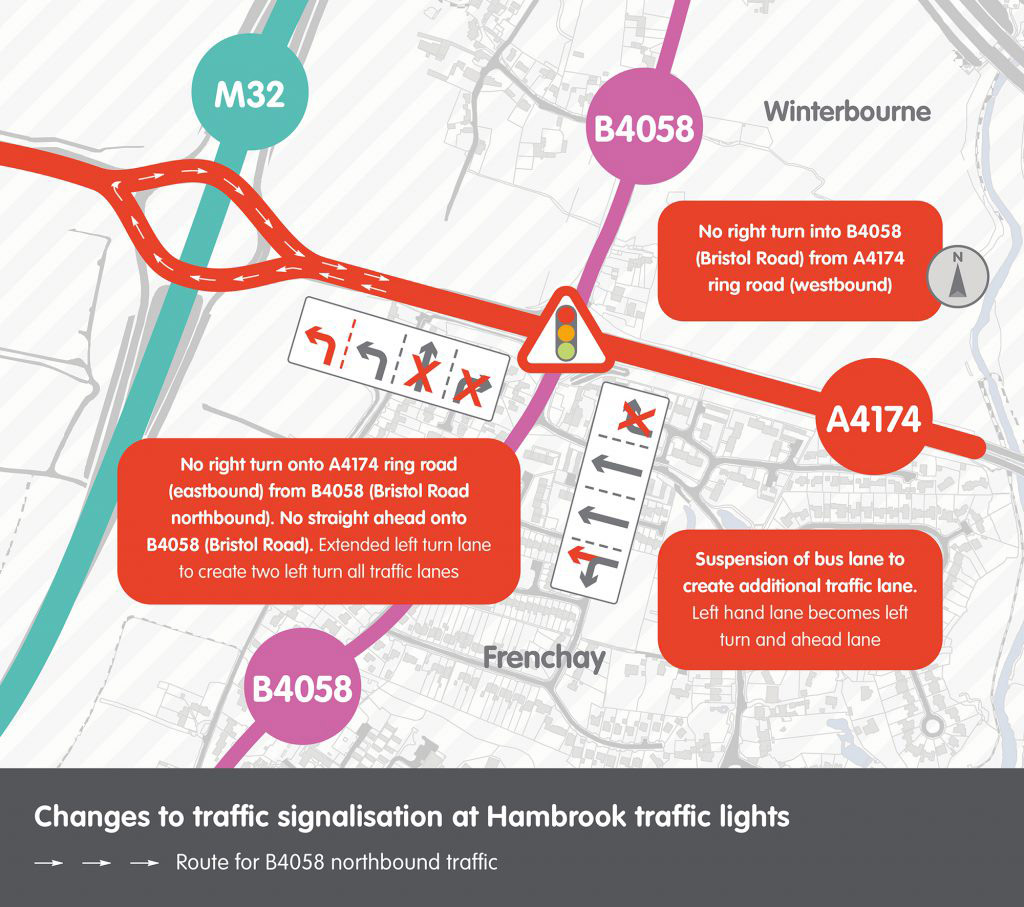Hambrook lights traffic restrictions
Page contents
Background
A national assessment of local authority roads by Defra (Department for Environment, Food & Rural Affairs) in 2017 identified the A4174 ring road, between the M32 Junction 1 and the Bromley Heath roundabouts, as being above the roadside nitrogen dioxide annual mean limit of 40 µg/m3 (microgrammes per cubic metre).
We were required by the government in 2018 to assess and introduce actions that could help reduce nitrogen dioxide levels to meet the legal limits in the shortest time possible.
Changes to the Hambrook junction
The following changes were implemented to the junction in 2019:
- changing the westbound bus lane to an all-traffic lane through the junction to the M32 traffic signals
- removal of the right turn onto the B4058 from the westbound carriageway of the A4174 ring road
- removal of the straight on movement for the B4058 northbound from Frenchay
- removal of the right turn from the B4058 from Frenchay onto the A4174

There are no changes to the direction of travel southbound on the B4058 from Winterbourne.
Impact of the changes
Journey times for some routes are slightly longer as drivers need to go around the M32 roundabout to access the B4058 northbound, and/or the ring road from Frenchay. To offset this, changing the bus lane to an all-traffic lane improves westbound capacity.
Reducing the time vehicles are stationary at the traffic lights and allowing ring road traffic to flow more efficiently, should reduce emissions and improve air quality.
Badminton Road M4 overbridge closure
The sudden closure of the National Highways M4 overbridge has impacted the surrounding road network including the Hambrook junction.
Similar restrictions were implemented at the Hambrook junction during the major repairs to Bromley Heath Viaduct a few years earlier, which helped the flow of traffic.
Air quality monitoring
We are continually monitoring the air quality at Hambrook. We are required to supply 2 consecutive years of compliant monitoring data to the government’s Joint Air Quality Unit (JAQU), which show that the roadside nitrogen dioxide levels are within the legal limit (40 µg/m3). JAQU was established by Defra and the Department for Transport to deliver the national nitrogen dioxide reduction strategies.
It took longer than expected to obtain the required data due to the Covid-19 pandemic. Data gathered for 2020 and 2021 was not typical and was not accepted as representative of normal conditions.
Recent monitoring data has shown significant improvements in the roadside nitrogen dioxide levels between the M32 and Bromley Heath roundabouts.
Assessment report 2022 and 2023
We submitted monitoring data for 2022 and 2023 to JAQU. They have assessed the data and produced an air quality assessment report.
The report found that the 2023 data was compliant but the 2022 data was not all within the legal limit. We need to provide another year of compliant data to show nitrogen dioxide levels can be maintained below the legal limit. We cannot review the restrictions until this has been achieved.
The 2024 data will be assessed by JAQU during 2025 and we will publish the assessment outcome when it is available.
Why we need to improve air quality
Air pollution is a significant public health issue.
Poor air quality has a number of adverse effects on health and is recognised as a contributing factor in the onset of heart disease and cancer. It particularly affects children and older people, and people already suffering from respiratory and cardiovascular conditions.
The UK has legislation to ensure that certain standards of air quality are met to protect health, but in some areas the standards have not been met.
The most immediate air quality challenge faced both at a national and local level is to meet the standards for the pollutant nitrogen dioxide (NO2). This type of pollution is largely caused by vehicle emissions, with road traffic contributing about 80% of the NO2 pollution around roads.
Find out more about air quality in South Gloucestershire.